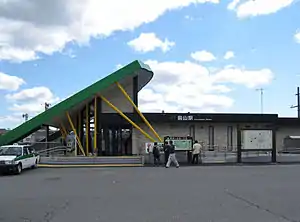Karasuyama Station
Karasuyama Station (烏山駅, Karasuyama-eki) is a railway station in the city of Nasukarasuyama, Tochigi, Japan, operated by the East Japan Railway Company (JR East).
Karasuyama Station 烏山駅 | |||||||||||
|---|---|---|---|---|---|---|---|---|---|---|---|
 The station building and forecourt in April 2014 after rebuilding | |||||||||||
| Location | 2-chōme-5 Minami, Nasukarasuyama-shi, Tochigi-ken 321-0627 Japan | ||||||||||
| Coordinates | 36°39′1.56″N 140°9′17.89″E | ||||||||||
| Operated by | |||||||||||
| Line(s) | ■ Karasuyama Line | ||||||||||
| Distance | 20.4 km from Hōshakuji | ||||||||||
| Platforms | 1 side platform | ||||||||||
| Connections | Bus stop | ||||||||||
| Other information | |||||||||||
| Status | Staffed | ||||||||||
| Website | Official website | ||||||||||
| History | |||||||||||
| Opened | 15 April 1923 | ||||||||||
| Passengers | |||||||||||
| FY2019 | 537 daily | ||||||||||
| Services | |||||||||||
| |||||||||||
| Location | |||||||||||
 Karasuyama Station Location within Tochigi Prefecture  Karasuyama Station Karasuyama Station (Japan) | |||||||||||
Lines
Karasuyama Station forms the terminus of the Karasuyama Line, a 20.4 km branch line from Hōshakuji.
Station layout
The station consists of one side platform serving a single track. The station formerly had a "Midori no Madoguchi" staffed ticket office, but this closed from August 2013, and tickets are available only from ticket vending machines.[1]
In February 2012, a recharging facility was built at the station for use by the experimental NE Train battery railcar, which is undergoing testing on the line. The recharging facility consists of a rigid overhead conductor enabling the train to be recharged via its pantograph. The overhead conductor bar is electrified at 1,500 V DC, powered from the local electricity grid 6.6 kV AC supply.[2]
 The overhead recharging facility, March 2014
The overhead recharging facility, March 2014 EV-E301 series battery EMU set V1 being recharged at Karasuyama Station, March 2014
EV-E301 series battery EMU set V1 being recharged at Karasuyama Station, March 2014 The substation feeding the recharging facility, April 2014
The substation feeding the recharging facility, April 2014
History
The station opened on 15 April 1923.[3]
 The station building and forecourt in August 2013, before rebuilding
The station building and forecourt in August 2013, before rebuilding The temporary station structure in December 2013, during rebuilding work
The temporary station structure in December 2013, during rebuilding work
Surrounding area
- Nasukarasuyama City Office
- Karasuyama High School
- Naka River
 National Route 294
National Route 294- Karasuyama Post Office
Passenger statistics
In fiscal 2019, the station was used by an average of 537 passengers daily (boarding passengers only).[4]
| Fiscal year | Daily average |
|---|---|
| 2000 | - |
| 2005 | 663[6] |
| 2010 | 555[7] |
| 2015 | 532[8] |
See also
References
- 烏山駅、8月に「みどりの窓口」廃止 [Karasuyama Station "Midori no Madoguchi" to close in August]. Shimotsuke Original Online News (in Japanese). Japan: Shimotsuke Shimbun. 23 July 2013. Archived from the original on 26 July 2013. Retrieved 26 July 2013.
- 「スマート電池くん」の実用性を確認する試験を実施します [Validation testing of "Smart Denchi-kun"] (PDF). Press release (in Japanese). Japan: East Japan Railway Company. 7 February 2012. Retrieved 9 July 2012.
- 日本国有鉄道停車場一覧 [JNR Station Directory]. Japan: Japanese National Railways. 1985. p. 112. ISBN 4-533-00503-9.
- 各駅の乗車人員 (2019年度) [Station passenger figures (Fiscal 2019)] (in Japanese). Japan: East Japan Railway Company. 2020. Retrieved 2 August 2020.
- 各駅の乗車人員 (2000年度) [Station passenger figures (Fiscal 2000)] (in Japanese). Japan: East Japan Railway Company. Archived from the original on 2 April 2019. Retrieved 9 July 2012.
- 各駅の乗車人員 (2005年度) [Station passenger figures (Fiscal 2005)] (in Japanese). Japan: East Japan Railway Company. Archived from the original on 2 April 2019. Retrieved 9 July 2012.
- 各駅の乗車人員 (2010年度) [Station passenger figures (Fiscal 2010)] (in Japanese). Japan: East Japan Railway Company. Retrieved 9 July 2012.
- 各駅の乗車人員 (2015年度) [Station passenger figures (Fiscal 2015)] (in Japanese). Japan: East Japan Railway Company. Retrieved 26 July 2019.
External links
| Wikimedia Commons has media related to Karasuyama Station. |
- JR East Station information (in Japanese)